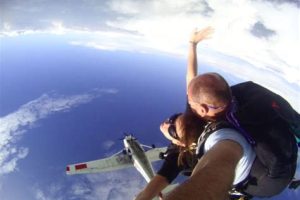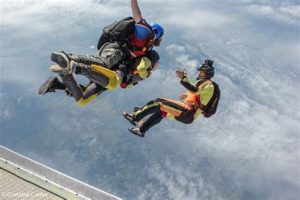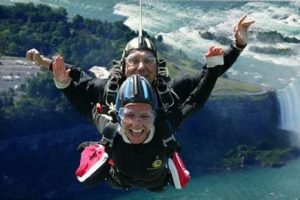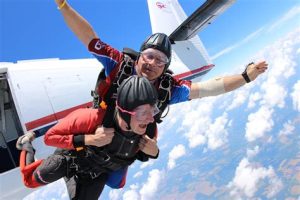Table of Contents
Discover the thrilling world of skydiving with a comparison between static line skydiving and tandem jumps. Static line skydiving allows you to experience the exhilaration of freefall solo, while tandem jumps provide the opportunity to jump with an experienced instructor. Explore the differences and choose the perfect skydiving adventure for you.
Are you ready to experience the thrill of freefalling from thousands of feet in the air? If so, then you may be considering either static line skydiving or tandem skydiving. Both options offer the opportunity to soar through the sky and feel the rush of adrenaline, but they differ in terms of the level of control and the overall experience. In this article, we will explore the key differences between static line skydiving and tandem skydiving, so you can make an informed decision about which one is right for you.
Introduction
When it comes to experiencing the thrill of skydiving, there are two popular methods that individuals can choose from: static line skydiving and tandem skydiving. Both offer unique experiences and have their own set of advantages and considerations. In this article, we will explore the differences between static line skydiving and tandem skydiving, helping you make an informed decision about which method suits you best.
What is Static Line Skydiving?
Static line skydiving is a method where the parachute is deployed automatically as the skydiver exits the aircraft. This technique involves a fixed line attached to the aircraft, which automatically deploys the main parachute shortly after leaving the plane. The skydiver then descends solo, guiding their own canopy to the ground.
What is Tandem Skydiving?
Tandem skydiving, on the other hand, involves a skydiver being harnessed to an experienced instructor throughout the entire jump. The instructor takes care of all the necessary procedures, including deploying the parachute and controlling the descent, while the participant enjoys the exhilarating freefall and views.
Experience Level
Static line skydiving is often preferred by individuals who seek more control and independence during their skydiving experience. It requires participants to complete a ground training course (typically 4-6 hours) to learn the necessary skills for deployment and canopy control. Tandem skydiving, on the other hand, requires minimal training as the instructor handles all the technical aspects, making it accessible to beginners and those who prefer a more guided experience.
Freefall and Time in the Air
One of the major differences between static line skydiving and tandem skydiving is the duration of freefall and time spent in the air. In static line skydiving, the freefall time is relatively shorter, usually around 10-20 seconds, as the parachute is deployed almost immediately after exiting the aircraft. Tandem skydiving, on the other hand, offers a longer freefall experience, typically lasting around 30-60 seconds, giving participants more time to enjoy the adrenaline rush and panoramic views.
Cost Considerations
In terms of cost, static line skydiving tends to be more affordable compared to tandem skydiving. Since static line skydivers require less equipment and instructor assistance, the overall price is lower. Tandem skydiving involves additional expenses due to the need for an experienced instructor and specialized tandem gear.
Safety Factors
Safety is a crucial aspect when it comes to skydiving. Both static line skydiving and tandem skydiving have their own safety considerations. Static line skydiving allows participants to have immediate access to their own parachute, providing an added sense of security. On the other hand, tandem skydiving involves being attached to an experienced instructor who takes care of all the safety procedures and equipment checks, ensuring a higher level of safety for beginners.
Equipment and Gear
The equipment used in static line skydiving and tandem skydiving also differs. In static line skydiving, participants typically use a static line, a main parachute, and reserve parachute. Tandem skydiving requires specialized tandem gear, including a larger canopy that can support the weight of two people. The gear used in both methods meets strict safety standards and is regularly inspected and maintained.
Adrenaline Rush
If you are seeking an intense adrenaline rush and the feeling of complete freedom, tandem skydiving may be the ideal choice for you. The longer freefall duration and the fact that you are securely attached to an instructor allow you to fully immerse yourself in the experience without worrying about the technical aspects. On the other hand, if you prefer more control and independence, static line skydiving provides a unique thrill as you take charge of your own descent.
Choosing the Right Method for You
When deciding between static line skydiving and tandem skydiving, it ultimately comes down to personal preference and what you hope to gain from the experience. If you want to learn the skills of skydiving and enjoy a sense of independence, static line skydiving may be the perfect fit. However, if you prefer a more guided and exhilarating freefall experience, tandem skydiving offers the opportunity to skydive with the support of an experienced instructor. Whichever method you choose, both static line skydiving and tandem skydiving guarantee an unforgettable adventure that will leave you with memories to cherish for a lifetime.
Title: A Comparison between Static Line Skydiving and Tandem Skydiving: Instructions and Information Guide
Introduction:
Welcome to our guide on comparing the characteristics and experiences of Static Line Skydiving and Tandem Skydiving. Below, you will find detailed information on each type, their differences, and what to expect from each style. Get ready for an adrenaline-fueled adventure and be prepared to make the leap!
1. Understanding Static Line Skydiving:
Static Line Skydiving involves an independent jump from an aircraft where the parachute automatically deploys shortly after exiting the plane. As a solo jumper, it is essential to undergo thorough training beforehand to ensure a safe and successful jump.
2. The Thrill of Tandem Skydiving:
Tandem Skydiving, on the other hand, involves a thrilling experience of descending from an aircraft while harnessed to a professional instructor. This style allows first-time skydivers to enjoy the thrill without being responsible for navigating the parachute or landing.
3. Training Requirements:
Before undertaking Static Line Skydiving, participants must undergo comprehensive training, which includes ground instruction, practice jumps, and learning how to deploy and control a parachute. This training equips jumpers with the necessary skills and knowledge for a safe and successful jump.
4. Safety Aspects:
Both Static Line Skydiving and Tandem Skydiving prioritize safety. In Static Line Skydiving, the automatic parachute deployment system ensures a controlled descent, while in Tandem Skydiving, the tandem jump instructors handle all technical aspects, ensuring a safe experience for first-time jumpers.
5. Freefall Experience:
Static Line Skydiving offers a unique freefall experience, allowing participants to relish the thrill of a solo jump while being responsible for their parachute and landing. Meanwhile, Tandem Skydiving offers the opportunity to enjoy the exhilarating freefall without the added responsibility, making it an excellent choice for beginners.
6. Solo Jump vs Tandem Experience:
Static Line Skydiving provides the opportunity for individual accomplishment as participants dive independently from the aircraft. Tandem Skydiving, on the other hand, offers a shared experience, allowing first-timers to share the excitement and emotions with their instructor, making it a great choice for those looking for an adrenaline-filled tandem adventure.
7. Accessibility and Availability:
Static Line Skydiving requires participants to undergo training and certification before they can experience solo jumps. Tandem Skydiving, however, is available to almost anyone, regardless of previous experience, as the tandem instructor takes care of all technical aspects, making it the ideal choice for beginners and curious individuals.
8. Choosing the Right Experience:
When deciding between Static Line Skydiving and Tandem Skydiving, consider your desired level of responsibility, thrill-seeking desires, and whether you prefer a solo or shared journey. Both options offer unparalleled experiences, so choose the one that aligns with your preferences and embark on an unforgettable skydiving adventure!
Conclusion:
Now that you have a comprehensive understanding of the similarities and differences between Static Line Skydiving and Tandem Skydiving, you can make an informed decision based on your personal preferences. Whether you choose to dive solo or tethered to a professional instructor, prepare yourself for a sensational experience that will leave you breathless and exhilarated. So, gear up, conquer your fears, and prepare to soar through the skies like never before!
Static Line Skydiving Vs Tandem: A Comparison
When it comes to experiencing the thrill of skydiving, two popular options are static line skydiving and tandem skydiving. Both methods offer unique experiences and have their own benefits. Let’s explore the differences between these two skydiving techniques:
- Experience:
- Static Line Skydiving: This method is suitable for those who want to experience the feeling of flying solo right from the start. You will jump from the plane alone, relying on a static line attached to the aircraft to automatically deploy your parachute.
- Tandem Skydiving: If you prefer to have a more controlled and guided experience, tandem skydiving is the way to go. You will be securely attached to a professional instructor who will handle all aspects of the jump, allowing you to simply enjoy the ride.
- Training:
- Static Line Skydiving: To participate in static line skydiving, you will need to undergo comprehensive training on the ground before your first jump. This training includes learning about equipment, safety procedures, landing techniques, and emergency protocols.
- Tandem Skydiving: The training required for tandem skydiving is relatively minimal compared to static line skydiving. Your instructor will provide you with a brief orientation session before the jump, ensuring you understand the basic safety guidelines and body positioning during freefall.
- Freefall Experience:
- Static Line Skydiving: With static line skydiving, you will experience a longer freefall compared to tandem skydiving. This allows you to enjoy the sensation of falling through the sky at a slower pace, giving you more time to take in the breathtaking views.
- Tandem Skydiving: During tandem skydiving, your instructor controls the freefall and ensures a smooth and controlled descent. While the freefall may be shorter than in static line skydiving, you can fully immerse yourself in the experience without worrying about deploying the parachute.
- Safety:
- Static Line Skydiving: As static line skydiving involves jumping solo, it requires a higher level of responsibility and adherence to safety protocols. However, with proper training and equipment, it can be a safe and enjoyable experience.
- Tandem Skydiving: Tandem skydiving is considered a safer option as you have an experienced instructor with you throughout the jump. They are responsible for ensuring a safe and successful landing, allowing you to focus on enjoying the adrenaline rush.
In conclusion, both static line skydiving and tandem skydiving offer thrilling adventures in the sky. The choice between the two ultimately depends on your personal preferences. If you desire the independence of flying solo and experiencing a longer freefall, opt for static line skydiving. On the other hand, if you prefer a more guided and secure experience, tandem skydiving is the perfect choice. Regardless of your decision, both methods guarantee an unforgettable adventure that will leave you with memories to last a lifetime!
Thank you for joining us on this exhilarating journey exploring the world of skydiving! We hope that this article has provided you with valuable insights into the adventure-filled options of static line skydiving and tandem jumps. As we come to a close, let’s recap the key points discussed and help you make an informed decision about which option suits you best.
If you are seeking a more independent and challenging experience, static line skydiving might be the perfect choice for you. With this method, you have the opportunity to cultivate your skills and gradually gain confidence as you progress through the training program. The feeling of accomplishment upon completing your first solo jump is unmatched, and it marks the beginning of a thrilling skydiving journey.
On the other hand, if you prefer a more relaxed and effortless introduction to the world of skydiving, tandem jumps offer an extraordinary experience. By being harnessed to an experienced instructor, you can fully immerse yourself in the joy of freefall without the added pressure of learning the technical aspects. This option allows you to focus solely on enjoying the breathtaking views and the adrenaline rush of soaring through the sky.
In conclusion, whether you choose static line skydiving or tandem jumps, both options offer their own unique benefits and unforgettable moments. It ultimately comes down to your personal preferences and the level of independence you desire during your skydiving experience. Regardless of which path you choose, one thing is certain – you are in for an incredible adventure that will leave you with memories to last a lifetime!
So, what are you waiting for? Take the leap and embark on your skydiving journey today. Whether you decide to start with static line skydiving or tandem jumps, remember to embrace the thrill, savor the adrenaline, and enjoy every moment of this extraordinary experience. Blue skies and safe landings to all the adventure seekers out there!
.
People also ask about Static Line Skydiving Vs Tandem:
1. What is the difference between static line skydiving and tandem skydiving?
Tandem skydiving involves being harnessed to a professional instructor who controls the entire jump, while static line skydiving is a solo jump where you deploy your own parachute.
2. Which one is safer, static line skydiving or tandem skydiving?
Tandem skydiving is generally considered safer as you have an experienced instructor guiding you throughout the entire jump. In static line skydiving, you are responsible for deploying your parachute on time.
3. Is static line skydiving more challenging than tandem skydiving?
Yes, static line skydiving requires more training and preparation compared to tandem skydiving. You need to learn how to properly deploy the parachute and handle any emergency situations that may arise during the jump.
4. Can anyone do static line skydiving or tandem skydiving?
Both static line skydiving and tandem skydiving have age and health requirements. However, tandem skydiving is more accessible to beginners and doesn’t require as much physical fitness or training as static line skydiving.
5. Which one provides a longer freefall experience, static line skydiving or tandem skydiving?
Tandem skydiving typically offers a longer freefall experience as you jump from a higher altitude compared to static line skydiving. In static line skydiving, the parachute is deployed shortly after exiting the aircraft, limiting the duration of the freefall.
6. Can I choose between static line skydiving and tandem skydiving at a skydiving center?
Most skydiving centers offer both static line and tandem skydiving options. However, availability may vary depending on the location and specific requirements of each skydiving center. It’s best to check with the center beforehand.
7. Do I need previous skydiving experience for static line skydiving or tandem skydiving?
No, previous skydiving experience is not required for either static line skydiving or tandem skydiving. Both options are suitable for beginners, although static line skydiving may require additional training and certification.
8. How much does static line skydiving and tandem skydiving cost?
The cost of both static line skydiving and tandem skydiving varies depending on the location and skydiving center. Tandem skydiving tends to be more expensive due to the presence of an instructor throughout the jump.
9. Which one is more popular among first-time skydivers, static line skydiving or tandem skydiving?
Tandem skydiving is generally more popular among first-time skydivers due to its accessibility and the added safety of having an instructor present. Static line skydiving is often pursued by individuals seeking a more independent and challenging skydiving experience.






